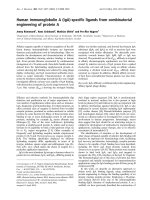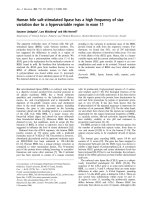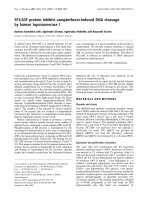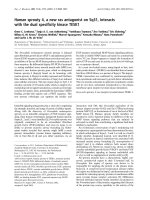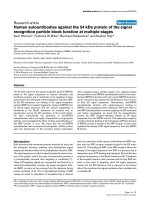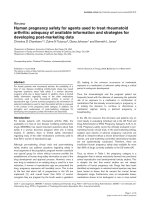Báo cáo y học: " Human APOBEC1 cytidine deaminase edits HBV DNA Minerva Cervantes Gonzalez, Rodolphe Suspène, Michel Henry, Denise Guétard, Simon Wain-Hobson and " pot
Bạn đang xem bản rút gọn của tài liệu. Xem và tải ngay bản đầy đủ của tài liệu tại đây (288.83 KB, 5 trang )
BioMed Central
Page 1 of 5
(page number not for citation purposes)
Retrovirology
Open Access
Short report
Human APOBEC1 cytidine deaminase edits HBV DNA
Minerva Cervantes Gonzalez, Rodolphe Suspène, Michel Henry,
Denise Guétard, Simon Wain-Hobson and Jean-Pierre Vartanian*
Address: Molecular Retrovirology Unit, Virology Department, Institut Pasteur, 28 rue du Dr Roux 75724 Paris cedex 15, France
Email: Minerva Cervantes Gonzalez - ; Rodolphe Suspène - ;
Michel Henry - ; Denise Guétard - ; Simon Wain-Hobson - ;
Jean-Pierre Vartanian* -
* Corresponding author
Abstract
Retroviruses, hepadnaviruses, and some other retroelements are vulnerable to editing by single
stranded DNA cytidine deaminases. Of the eleven human genes encoding such enzymes, eight have
demonstrable enzymatic activity. Six of seven human APOBEC3 are able to hyperedit HBV DNA,
frequently on both strands. Although human APOBEC1 (hA1) is not generally expressed in normal
liver, hA1 can edit single stranded DNA in a variety of experimental assays. The possibility of
ectopic expression of hA1 in vivo cannot be ruled out and interestingly, transgenic mice with A1
expressed under a liver specific promoter develop hepatocellular carcinoma. The impact of hA1 on
HBV in tissue culture is varied with reports noting either reduced DNA synthesis or not, with
cytidine deamination taking a low profile. We sought to examine the hA1 editing activity on
replicating HBV. Using highly sensitive 3DPCR it was possible to show that hA1 edits the HBV
minus DNA strand as efficiently as hA3G, considered the reference deaminase for HIV and HBV.
The dinucleotide specificity of editing was unique among human cytidine deaminases providing a
hallmark of use in a posteriori analyses of in vivo edited genomes. Analysis of sequences derived from
the serum of two chronic carriers, indicated that hA1 explained only a small fraction of edited HBV
genomes. By contrast, several human APOBEC3 deaminases were active including hA3G.
Findings
Despite being the prototypic human cytidine deaminase,
human APOBEC1 (hA1) first identified in 1995 has been
overshadowed by other paralogs, notably activation
induced cytidine deaminase (AICDA) and the APOBEC3
gene cluster at ch22q13.1 [1-3]. Human A1 (hA1) edits a
single cytidine residue in human apolipoprotein B (apoB)
mRNA, a specificity that is conferred by its major interac-
tor, ACF, its expression being confined to intestinal epi-
thelial cells [4,5]. By contrast, the mouse, rat, dog and
horse A1s are expressed in the intestine and other organs
including the liver [2,6,7]. This situation is probably due
to an Alu insertion in a part of the hA1 gene inactivating a
generalist promoter [8,9]. RNA editing specificity can
break down in rabbit A1 transgenic mice where hyperedit-
ing of the apoB mRNA was described [10] and subse-
quently noted in normal mouse intestinal tissues [11]. For
transgenic mice expressing the rabbit APOBEC1 gene
under the control of a liver specific promoter, hepatic dys-
plasia and hepatocellular carcinomas were found [12].
Whether this is due to RNA or DNA editing is unknown
although in an E. coli DNA mutator assay, hA1 was highly
mutagenic meaning that the latter cannot be ruled out
[13]. It turned out that human and mouse/rat A1 enzymes
Published: 21 October 2009
Retrovirology 2009, 6:96 doi:10.1186/1742-4690-6-96
Received: 8 July 2009
Accepted: 21 October 2009
This article is available from: />© 2009 Gonzalez et al; licensee BioMed Central Ltd.
This is an Open Access article distributed under the terms of the Creative Commons Attribution License ( />),
which permits unrestricted use, distribution, and reproduction in any medium, provided the original work is properly cited.
Retrovirology 2009, 6:96 />Page 2 of 5
(page number not for citation purposes)
are not true orthologs in that the rodent enzymes can
hyperedit both RNA and DNA, unlike hA1 that can only
deaminate ssDNA [13]. By contrast AICDA and the
human APOBEC3 (hA3) show an exclusive single
stranded DNA substrate specificity [14-27].
As retroviruses and hepadnaviruses replicate via a single
stranded cDNA intermediate, it is not surprising that
some are vulnerable to the effects of these cytidine deam-
inases if expressed in the target cell. While there is a huge
literature on the interaction between human immunode-
ficiency virus (HIV) and the hA3 cluster of genes (the hA3
genes), most of them can also edit hepatitis B virus (HBV)
DNA [28-33]. The role of A1 genes on retroviral replica-
tion is somewhat checkered. One report has shown that
HBV replication is restricted by hA1 yet doesn't address
the question of editing [34]. By contrast, another study
shows that the rat A1 deaminase hardly impacts HBV rep-
lication, even though a little cytidine deamination was
found [30]. Both hA1 and rat A1 impact HIV replication
in single cycle growth assays [35]. In the mouse A1 hardly
restricts Friend murine leukemia virus replication,
although using highly sensitive 3DPCR hypermutants
were recovered from a small fraction of cultured cells or
splenocytes from infected mice [11].
We sought to investigate the editing capacity of hA1 on
HBV replication using 3DPCR [28,31,32]. An infectious
molecular clone of HBV was transfected into quail QT6
cells with hA1 along with human APOBEC2 (hA2) and
human APOBEC3G (hA3G) as negative and positive con-
trols. QT6 cells were used so as to eliminate the endog-
enous APOBEC background typical of mammalian and
human cell lines [28]. At 72 h culture supernatants and
cell lysates were recovered. Western blotting of whole cell
lysates showed that all three APOBEC constructs were pro-
duced without obvious degradation (Figure 1A), the levels
of hA1 and hA3G being particularly comparable. Using
SYBR green quantification of HBV DNA, when normal-
ized to the empty expression vector transfection control,
hA1 and hA3G clearly impacted DNA replication (Figure
1B). PCR was performed on the HBV X gene using a con-
ventional two-step procedure as previously described
[28,31]. Amplification performed using a 95°C denatura-
tion temperature recovered HBV DNA in all samples,
apart from the negative DNA control (Figure 1C). When
3DPCR was performed on these PCR products at the
restricting temperature of 88.7°C, DNA was recovered
only from the hA1 and hA3G transfections (Figure 1C).
Cloning and sequencing of 24 clones identified so-called
G->A hypermutants indicative of genetic editing of the
minus DNA strand or cDNA, the frequency distribution of
edited genomes per sequence being generally comparable
(Figure 1D). No C->T hypermutants, indicative of plus
strand editing, were recovered. The mutation matrices
(Figure 1E) and editing frequencies were strictly compara-
ble, hA1 32% (range 16-52%) while that for hA3G was
34% (range 25-41%). In short, hA1 is every bit as efficient
as hA3G in editing HBV DNA.
As the dinucleotide context of editing is frequently a hall-
mark of different deaminases, for example hA3G shows a
strong preference for CpC, while hA3H prefers TpC, the
hA1 edited genomes were so analyzed. As can be seen
from Figure 1F, hA1 showed a strong preference for TpC
and a strong aversion for GpC. It was neutral with respect
to ApC. All other hA3 deaminases (hA3s) either avoid
GpC and ApC or are neutral (hA3A, hA3C, [28]). Hence,
along with the preference for TpC, this feature is highly
distinctive of hA1 editing.
Of course in vivo, one or more APOBEC deaminases could
be operative, either in different HBV infected cells or even
within the same cell. Hence global dinucleotide analyses
of edited genomes from patients might be misleading.
Comparative analysis of the dinucleotide contexts for
individual in vivo hyperedited sequences with reference
sets derived from transfections with individual hA1 or
hA3 genes should help highlight those deaminases opera-
tive in vivo. The only exception would be if two different
hA3 enzymes were packaged in the same virion. As can be
seen plotting the number of edited TpC vs. CpC sites
allows a clear distinction between hA1 and hA3G edited
sequences (Figure 2A). The same is true for GpC vs. ApC
(Figure 2B), although the number of deaminated bases is
far fewer, meaning that the observation is a little less
robust. The distinction between hA1 and hA3G could be
emphasized by analyzing TpC+ApC (unique to hA1) vs.
GpC+CpC (Figure 2C).
We have previously reported hA3 editing of HBV genomes
from sera derived from two chronically infected patients
with high viremia (> 10
9
DNA copies/ml, [31]). Single
molecule analysis of these sequences showed that there
was more overlap between the patient data "clouds" than
with that of hA3G. Although the individual dinucleotide
analyses might suggest that a few genomes are edited by
hA1 in vivo (Figures 2D, E vs. 2A, B), the combined dinu-
cleotide analysis (Figure 2C vs. 2F) showed no overlap
with the hA1 edited sequence set. We have previously
shown that the dinucleotide bias for individual hA3
deaminases varies with the base composition of the locus
[28]; hence, it is not possible to extend the analysis to
other edited regions of the HBV genome.
As ~20 hypermutated sequences were derived from each
of the sera, the resolution of the argument is ~5%. Obvi-
ously with 10 times more patient sequences it might be
able to find bona fide evidence of a little hA1 editing. By
contrast, hA3G accounts for a sizeable fraction (79% and
Retrovirology 2009, 6:96 />Page 3 of 5
(page number not for citation purposes)
58% respectively for patients 130.71 and 12763). Accord-
ingly, other hA3 deaminases must be involved; yet given
the similarities between the editing contexts of hA3A,
hA3B and hA3C, it is not possible to be more precise. Fur-
thermore, chronic hepatitis shows many facets; and
although hA1 expression is confined to the intestinal epi-
thelium and not the liver [6], its expression profile in a
variety of different clinical presentations including highly
inflamed cirrhotic tissue is not known.
As mentioned above, hA1 transgenic mice under the con-
trol of the liver specific apoE promoter presented with
hepatic dysplasia and ultimately liver cancer; thus, the
role of cytidine deamination remains open. Even though
hA1 does not edit HBV at a high frequency, because hA1
can shuttle between the cytoplasm and nucleus, it is
potentially a more likely pro-cancerous candidate than
hA3G, which is strictly cytoplasmic.
Human APOBEC1 can efficiently hyperedit HBV minus strand DNAFigure 1
Human APOBEC1 can efficiently hyperedit HBV minus strand DNA. A) Western blotting of V5 tagged hA1, hA2 and
hA3G cDNA constructs. Molecular weight markers (kDa) are given to the left. B) Reduction of HBV DNA production follow-
ing cotransfection of QT6 cells with HBV ± hA1 ± hA3G. C) PCR and 3DPCR of HBV X region DNA from transfections. C-,
no DNA control; C+, HBV alone; pv, plasmid vector control; hA1, V5-tagged human APOBEC1 expression plasmid; hA2, V5
tagged human APOBEC2; hA3G, V5-tagged human APOBEC3G as positive control. M, molecular weight markers. The sizes of
the PCR and 3DPCR fragments are 314 and 213 bps. D) Frequency distribution of G->A hypermutants in terms of mutations
per clone. E) Mutation matrices of 24 hA1 and hA3G hyperedited HBV sequences. The size of the locus is 167 bp. F) Dinucle-
otide analysis of hA1 and hA3G edited HBV genomes. A
2
analysis showed that frequencies for hA1 and hA3G deviated signif-
icantly from the expected values as indicated by asterisks (p < 0.001).
hA1 hA2 hA3G
39
28
51
°C
TCGA
T
C
G
A
100
0
0
0
0
33
323
00
T
C
GA
T
C
G
A
2
0
0
0
0
0
0
0
2
342
00
°C
0
20
40
60
80
hA1
hA3G
Exp.
CpCTpC GpC ApC
%
*
*
M C- C+ pv hA1 hA2 hA3G M
HBV+
Td=
95°C
Td=
88.7°C
%
HBV
DNA
0
25
50
75
100
hA1
hA3G
A
BD
C
EF
# mutations per clone
hA3G
hA1
# clones
2 4 6 8 10 12 14 16 18 20 22 24
0
2
4
6
8
*
*
Retrovirology 2009, 6:96 />Page 4 of 5
(page number not for citation purposes)
Abbreviations
3DPCR: Differential DNA denaturation PCR; ACF:
APOBEC1 complementary factor; hAICDA: Human acti-
vation induced cytidine deaminase; hAPOBEC1, hA1:
Human apolipoprotein B editing complex protein 1;
hAPOBEC2, hA2: Human apolipoprotein B editing com-
plex protein 2; hAPOBEC3, hA3: Human apolipoprotein
B editing complex protein 3; hAPOBEC3A-H, hA3A-H:
Human apolipoprotein B editing complex protein 3 pro-
teins A to H; HBV: Hepatitis B virus; HIV-1: Human
Immunodeficiency virus type 1.
Competing interests
The authors declare that they have no competing interests.
Authors' contributions
MCG, MH, DG and RS performed the work. SWH and JPV
designed the study and wrote the paper.
Acknowledgements
This work was supported by grants from the Institut Pasteur, ANRS and
CNRS. MCG and RS were supported by a bursaries from CONACYT
(Mexico) and ARC respectively.
References
1. Jarmuz A, Chester A, Bayliss J, Gisbourne J, Dunham I, Scott J, Navar-
atnam N: An anthropoid-specific locus of orphan C to U RNA-
editing enzymes on chromosome 22. Genomics 2002,
79:285-296.
2. Lau PP, Zhu HJ, Baldini A, Charnsangavej C, Chan L: Dimeric struc-
ture of a human apolipoprotein B mRNA editing protein and
cloning and chromosomal localization of its gene. Proc Natl
Acad Sci USA 1994, 91:8522-8526.
3. Teng B, Burant CF, Davidson NO: Molecular cloning of an apoli-
poprotein B messenger RNA editing protein. Science 1993,
260:1816-1819.
Single molecule analysis of hyperedited HBV DNAFigure 2
Single molecule analysis of hyperedited HBV DNA. Based on the macroscopic trends identified in Figure 1F, mutated
dinucleotide frequencies were plotted for individual minus strand hyperedited sequences. The units are numbers of NpC
edited sites per clone. A-C) Data from HBV co-transfections with hA1 and hA3G (24 sequences each). D-F) Patient data from
two individuals with high viremia chronic hepatitis (#12763, 19 sequences, ~10
9
DNA copies/mL; #130.71, 21 sequences, ~3
10
9
DNA copies/mL). For A to F, a few data points overlap; hence the number of points is less than the number of sequences.
The diagonals represent the expected values assuming no dinucleotide preference. As the base composition differs between
the sequences of the two HBV strains, dinucleotide composition varies and the expected values accordingly.
Patient 12763Patient 130.71
hA1
hA3G
0
2
4
6
8
TpC
CpC
5100
0
2
4
6
8
TpC
CpC
5100
0
5
10
15
20
TpC+ApC
GpC+CpC
5100152025
0
5
10
15
20
GpC+CpC
TpC+ApC
130.71
12763
5100152025
0
2
4
6
8
10
ApC
GpC
5100
0
2
4
6
8
10
ApC
GpC
5100
12763
130.71
ABC
DEF
Publish with BioMed Central and every
scientist can read your work free of charge
"BioMed Central will be the most significant development for
disseminating the results of biomedical research in our lifetime."
Sir Paul Nurse, Cancer Research UK
Your research papers will be:
available free of charge to the entire biomedical community
peer reviewed and published immediately upon acceptance
cited in PubMed and archived on PubMed Central
yours — you keep the copyright
Submit your manuscript here:
/>BioMedcentral
Retrovirology 2009, 6:96 />Page 5 of 5
(page number not for citation purposes)
4. Chester A, Weinreb V, Carter CW Jr, Navaratnam N: Optimiza-
tion of apolipoprotein B mRNA editing by APOBEC1 apoen-
zyme and the role of its auxiliary factor, ACF. RNA 2004,
10:1399-1411.
5. Maris C, Masse J, Chester A, Navaratnam N, Allain FH: NMR struc-
ture of the apoB mRNA stem-loop and its interaction with
the C to U editing APOBEC1 complementary factor. RNA
2005, 11:173-186.
6. Greeve J, Altkemper I, Dieterich JH, Greten H, Windler E: Apolipo-
protein B mRNA editing in 12 different mammalian species:
hepatic expression is reflected in low concentrations of
apoB-containing plasma lipoproteins. J Lipid Res 1993,
34:1367-1383.
7. Nakamuta M, Oka K, Krushkal J, Kobayashi K, Yamamoto M, Li WH,
Chan L: Alternative mRNA splicing and differential promoter
utilization determine tissue-specific expression of the apoli-
poprotein B mRNA-editing protein (Apobec1) gene in mice.
Structure and evolution of Apobec1 and related nucleoside/
nucleotide deaminases. J Biol Chem 1995, 270:13042-13056.
8. Greeve J, Axelos D, Welker S, Schipper M, Greten H: Distinct pro-
moters induce APOBEC-1 expression in rat liver and intes-
tine. Arterioscler Thromb Vasc Biol 1998, 18:1079-1092.
9. Hirano K, Min J, Funahashi T, Davidson NO: Cloning and charac-
terization of the rat apobec-1 gene: a comparative analysis of
gene structure and promoter usage in rat and mouse. J Lipid
Res 1997, 38:1103-1119.
10. Innerarity TL, Boren J, Yamanaka S, Olofsson SO: Biosynthesis of
apolipoprotein B48-containing lipoproteins. Regulation by
novel post-transcriptional mechanisms. J Biol Chem 1996,
271:2353-2356.
11. Petit V, Guetard D, Renard M, Keriel A, Sitbon M, Wain-Hobson S,
Vartanian JP: Murine APOBEC1 is a powerful mutator of ret-
roviral and cellular RNA in vitro and in vivo. J Mol Biol 2009,
385:65-78.
12. Yamanaka S, Balestra ME, Ferrell LD, Fan J, Arnold KS, Taylor S, Tay-
lor JM, Innerarity TL: Apolipoprotein B mRNA-editing protein
induces hepatocellular carcinoma and dysplasia in transgenic
animals. Proc Natl Acad Sci USA 1995,
92:8483-8487.
13. Harris RS, Petersen-Mahrt SK, Neuberger MS: RNA editing
enzyme APOBEC1 and some of its homologs can act as
DNA mutators. Mol Cell 2002, 10:1247-1253.
14. Beale RC, Petersen-Mahrt SK, Watt IN, Harris RS, Rada C, Neu-
berger MS: Comparison of the differential context-depend-
ence of DNA deamination by APOBEC enzymes:
correlation with mutation spectra in vivo. J Mol Biol 2004,
337:585-596.
15. Bishop KN, Holmes RK, Sheehy AM, Davidson NO, Cho SJ, Malim
MH: Cytidine deamination of retroviral DNA by diverse
APOBEC proteins. Curr Biol 2004, 14:1392-1396.
16. Chelico L, Pham P, Calabrese P, Goodman MF: APOBEC3G DNA
deaminase acts processively 3' -> 5' on single-stranded DNA.
Nat Struct Mol Biol 2006, 13:392-9.
17. Chelico L, Pham P, Goodman MF: Stochastic properties of
processive cytidine DNA deaminases AID and APOBEC3G.
Phil Trans R Soc Lond B 2009, 364:583-593.
18. Harris RS, Bishop KN, Sheehy AM, Craig HM, Petersen-Mahrt SK,
Watt IN, Neuberger MS, Malim MH: DNA deamination mediates
innate immunity to retroviral infection. Cell 2003,
113:803-809.
19. Lecossier D, Bouchonnet F, Clavel F, Hance AJ: Hypermutation of
HIV-1 DNA in the absence of the Vif protein. Science 2003,
300:1112.
20. Liddament MT, Brown WL, Schumacher AJ, Harris RS: APOBEC3F
properties and hypermutation preferences indicate activity
against HIV-1 in vivo. Curr Biol 2004, 14:1385-1391.
21. Mangeat B, Turelli P, Caron G, Friedli M, Perrin L, Trono D: Broad
antiretroviral defence by human APOBEC3G through lethal
editing of nascent reverse transcripts. Nature 2003,
424:99-103.
22. Mariani R, Chen D, Schrofelbauer B, Navarro F, Konig R, Bollman B,
Munk C, Nymark-McMahon H, Landau NR: Species-specific exclu-
sion of APOBEC3G from HIV-1 virions by Vif. Cell 2003,
114:21-31.
23. Shivarov V, Shinkura R, Honjo T: Dissociation of in vitro DNA
deamination activity and physiological functions of AID
mutants. Proc Natl Acad Sci USA 2008, 105:15866-15871.
24. Suspène R, Sommer P, Henry M, Ferris S, Guetard D, Pochet S, Ches-
ter A, Navaratnam N, Wain-Hobson S, Vartanian JP: APOBEC3G is
a single-stranded DNA cytidine deaminase and functions
independently of HIV reverse transcriptase. Nucleic Acids Res
2004, 32:2421-2429.
25. Wiegand HL, Doehle BP, Bogerd HP, Cullen BR: A second human
antiretroviral factor, APOBEC3F, is suppressed by the HIV-
1 and HIV-2 Vif proteins. EMBO J 2004, 23:2451-2458.
26. Yu Q, Konig R, Pillai S, Chiles K, Kearney M, Palmer S, Richman D,
Coffin JM, Landau NR: Single-strand specificity of APOBEC3G
accounts for minus-strand deamination of the HIV genome.
Nat Struct Mol Biol 2004, 11:435-442.
27. Zhang H, Yang B, Pomerantz RJ, Zhang C, Arunachalam SC, Gao L:
The cytidine deaminase CEM15 induces hypermutation in
newly synthesized HIV-1 DNA. Nature 2003, 424:94-98.
28. Henry M, Guetard D, Suspene R, Rusniok C, Wain-Hobson S, Varta-
nian JP: Genetic editing of HBV DNA by monodomain human
APOBEC3 cytidine deaminases and the recombinant nature
of APOBEC3G. PLoS ONE 2009, 4:e4277.
29. Noguchi C, Ishino H, Tsuge M, Fujimoto Y, Imamura M, Takahashi S,
Chayama K: G to A hypermutation of hepatitis B virus. Hepa-
tology 2005, 41:626-633.
30. Rosler C, Kock J, Kann M, Malim MH, Blum HE, Baumert TF, von
Weizsacker F: APOBEC-mediated interference with hepadna-
virus production. Hepatology 2005, 42:301-309.
31. Suspène R, Guétard D, Henry M, Sommer P, Wain-Hobson S, Varta-
nian JP: Extensive editing of both hepatitis B virus DNA
strands by APOBEC3 cytidine deaminases in vitro and in
vivo. Proc Natl Acad Sci USA 2005, 102:8321-8326.
32. Suspène R, Henry M, Guillot S, Wain-Hobson S, Vartanian JP: Recov-
ery of APOBEC3-edited human immunodeficiency virus G-
>A hypermutants by differential DNA denaturation PCR. J
Gen Virol 2005, 86:125-129.
33. Turelli P, Mangeat B, Jost S, Vianin S, Trono D: Inhibition of hepa-
titis B virus replication by APOBEC3G. Science 2004, 303:
1829.
34. Jost S, Turelli P, Mangeat B, Protzer U, Trono D: Induction of anti-
viral cytidine deaminases does not explain the inhibition of
hepatitis B virus replication by interferons. J Virol 2007,
81:10588-10596.
35. Bishop KN, Holmes RK, Sheehy AM, Malim MH: APOBEC-medi-
ated editing of viral RNA. Science 2004, 305:645.

